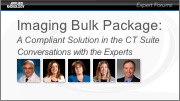|
Available Programs and Courses
FOR Pharmacist
|
|
A complete listing of currently available online programs is provided below. To view course materials click an available viewing format provided with each listing (PDF, HTML, Interactive). To access online exams and claim credit you must be registered and logged in. To add courses to your "MyAR Archives" user account select the "Add To Cart" button provided with each course title and follow the prompts.
|
Contrast Media Basics: Important Considerations for the Pharmacist
|
|
Released:
March 17, 2024
•Expires:
March 17, 2026
|
CE credits:
2.5
• Cost:
$0.00
|
|
Faculty:
William Faulkner, B.S.,R.T.(R)(MR)(CT), FSMRT | Kristan Harrington, MBA, R.T.(R)(MR), ARRT, MRSO | Rutu Patel, PharmD, RPh
|
Applied Radiology has developed this two-part, on-demand webinar and accompanying digital monograph to increase overall understanding of the properties, clinical benefits, and safety considerations of iodinated and gadolinium-based contrast agents (GBCAs). The goal of this program is to fully prepare pharmacy personnel to make informed decisions regarding contrast media selection.
The complete online program has been approved for up to 2.5 ACPE and Category A ARRT continuing educational credits.
Part 1: Contrast Media Basics
Part 2: A Pharmacist’s Guide to Gadolinium-Based Contrast Agents
Part 3: Monograph
This program was supported through an educational grant from Bracco Diagnostics, Inc.
|
|
|
|
|
Gadopiclenol Injection | Practical Considerations for Use
|
|
Released:
June 1, 2025
•Expires:
June 1, 2027
|
CE credits:
1.0
• Cost:
$0.00
|
|
Faculty:
William Faulkner, B.S.,R.T.(R)(MR)(CT), FSMRT
|

With the recent FDA approval of gadopiclenol injection, radiologists now have the choice of a macrocyclic gadolinium-based contrast agent (GBCA) with 2 – 3 times higher relaxivity at a lower standard dose as compared to other gadolinium-based contrast agents on the marke
Therefore, and because gadopiclenlol is different than other currently available GBCAs, a review of the clinical benefits of using a higher relaxivity GBCA at a lower administered dose is important. A clear understanding of relaxivity and calculation of the volume to be administered based on dosing considerations, is necessary
In this accredited webinar, Mr. Faulkner will provide insights into the differences of the current FDA-approved GBCAs and how these differences apply to MR imaging. Following the presentation, questions from the audience were addressed during a live Q&A.
Educational Objectives:
At the completion of this activity, participants should be able to:
-
Identify the properties that distinguish gadopiclenol injection from the other high relaxivity and conventional gadolinium-based contrast agents (GBCAs).
-
Employ the FDA-approved indications and clinical applications for gadopiclenol injection.
-
Calculate and administer the proper volume dose of gadopiclenol, as compared to other conventional GBCAs.
-
Apply clinical considerations and dosing options for gadopiclenol to vulnerable patient populations who may experience repeat dosing of GBCA.
Made possible through an unrestricted educational grant from Bracco Diagnostics, Inc.
|
|
|
|
|
Imaging Bulk Package: A Compliant Solution in the CT Suite
|
|
Released:
May 7, 2025
•Expires:
May 6, 2027
|
CE credits:
1.0
• Cost:
$0.00
|
|
Faculty:
Assorted Faculty
|

Since the 1990’s, multi-patient contrast administration has been available in the form of the Pharmacy Bulk Package (PBP), which is still offered by several contrast vendors. The FDA required that all related Prescribing Information (PI) sheets for the PBP include specific directions for the dispensing of the contrast from the PBP container. The PI language describes withdrawing the contrast from the bottle in a suitable work area, specifically “a laminar flow hood, using aseptic techniques”. However, this method is not possible in most CT Suites, as laminar flow hoods are generally located in the Pharmacy, not the CT suite.
Therefore, during the last decade, regulators have begun to have concerns about the use of PBP. In 2009, The Joint Commission began citing imaging providers who were using PBP to fill power injector syringes in what they considered an unsuitable work area, as described in the manufacturer’s PBP guidelines for the dispensing of contrast.
This Expert Forum will review the steps taken by the contrast media industry and the FDA to develop a safe and compliant solution for multi-patent contrast administration in CT. This solution is now available as the Imaging Bulk Package (IBP) which is approved for use in the CT Suite. This panel will also share their comprehensive process for incorporating IBP into their clinical practice.
Supported through an unrestricted educational grant from Bracco Diagnostics Inc.
|
|
|
|